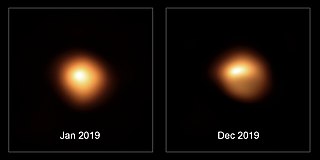
A variable star is a star whose brightness as seen from Earth changes with time. This variation may be caused by a change in emitted light or by something partly blocking the light, so variable stars are classified as either:

Beta Centauri is a triple star system in the southern constellation of Centaurus. It is officially called Hadar. The Bayer designation of Beta Centauri is Latinised from β Centauri, and abbreviated Beta Cen or β Cen. The system's combined apparent visual magnitude of 0.61 makes it the second-brightest object in Centaurus and the eleventh brightest star in the night sky. According to parallax measurements from the astrometric Hipparcos satellite, the distance to this system is about 390 light-years.

The descriptive term long-period variable star refers to various groups of cool luminous pulsating variable stars. It is frequently abbreviated to LPV.
Beta Cephei variables, also known as Beta Canis Majoris stars, are variable stars that exhibit small rapid variations in their brightness due to pulsations of the stars' surfaces, thought due to the unusual properties of iron at temperatures of 200,000 K in their interiors. These stars are usually hot blue-white stars of spectral class B and should not be confused with Cepheid variables, which are named after Delta Cephei and are luminous supergiant stars.

Gamma Doradus variables are variable stars which display variations in luminosity due to non-radial pulsations of their surface. The stars are typically young, early F or late A type main sequence stars, and typical brightness fluctuations are 0.1 magnitudes with periods on the order of one day. This class of variable stars is relatively new, having been first characterized in the second half of the 1990s, and details on the underlying physical cause of the variations remains under investigation.
Alpha Cygni variables are variable stars which exhibit non-radial pulsations, meaning that some portions of the stellar surface are contracting at the same time other parts expand. They are supergiant stars of spectral types B or A. Variations in brightness on the order of 0.1 magnitudes are associated with the pulsations, which often seem irregular, due to beating of multiple pulsation periods. The pulsations typically have periods of several days to several weeks.
Nu Cephei is a class A2, fourth-magnitude supergiant star in the constellation Cepheus. It is a white pulsating α Cygni variable star located about 4,700 light-years from Earth.
A Lambda Eridani Variable is a class of Be stars that show small amplitude variations of a few hundredths of a magnitude. The variations are highly regular with periods between 0.5 and 2.0 days, and they were initially described as periodic Be stars. Lambda Eridani is an example and the prototype. This has been ascribed to non-radial pulsations, inhomogeneous rotating discs, or the rotation of the star itself.
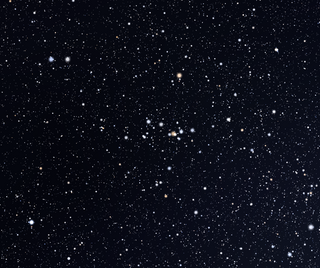
DY Persei is a variable star and carbon star in the Perseus constellation. At maximum it is 11th magnitude and at its faintest it drops to 16th magnitude. DY Persei is the prototype of the very rare DY Persei class of variables that pulsate like red variables but also fade from sight like R Coronae Borealis variables.

DL Crucis is a variable star in the constellation Crux.

3 Vulpeculae is a binary star system in the northern constellation of Vulpecula, located around 360 light years away from the Sun. 3 Vulpeculae is its Flamsteed designation. It is visible to the naked eye as a faint, blue-white hued star with a baseline apparent visual magnitude of 5.18.

1 Persei is an eclipsing binary star in the constellation Perseus. Its uneclipsed apparent magnitude is 5.49. The binary star consists of two B2 type main-sequence stars in a 25.9 day eccentric orbit. The stars are surrounded by a faint cloud of gas visible in mid-infrared, although whether they are the origin of the gas or simply passing through it is unclear.

HY Velorum is a binary star system in the southern constellation of Vela. It is a dim star but visible to the naked eye with an apparent visual magnitude of 4.83. The distance to this system, as estimated from its annual parallax shift of 7.1 mas, is 460 light years. HY Vel most likely forms a gravitationally bound pair with the magnitude 5.45 binary system KT Vel ; both are members of the IC 2391 open cluster. As of 1998, HY Vel and KT Vel had an angular separation of 76.1″ along a position angle of 311°.
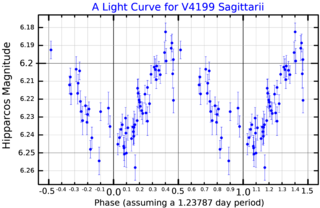
V4199 Sagittarii is a variable star in the southern constellation of Sagittarius. It is a dim star that is just visible to the naked eye with an apparent visual magnitude that varies between 6.22 and 6.28 over a period of 1.23825 days. The star is located at a distance of approximately 689 light years from the Sun based on parallax, but is drifting closer with a radial velocity of roughly −23 km/s. It has an absolute magnitude of −0.63, on average.

25 Serpentis is a star system in the constellation of Serpens Caput. With an apparent magnitude of 5.37, it is just barely visible to the naked eye. The system is estimated to be some 450 light-years based on its parallax.
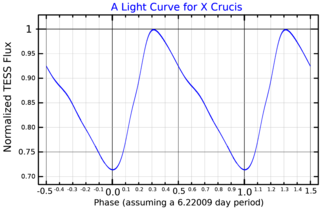
X Crucis is a classical Cepheid variable star in the southern constellation of Crux.

XX Persei is a semiregular variable red supergiant star in the constellation Perseus, between the Double Cluster and the border with Andromeda.
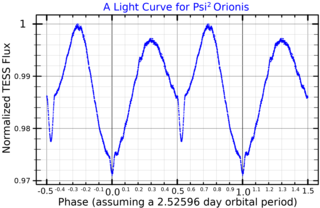
Psi2 Orionis a binary star system in the equatorial constellation of Orion. It has an apparent visual magnitude of 4.6, indicating that it is visible to the naked eye. Based upon an annual parallax shift of 2.87 mass, it is roughly 1,100 light years distant from the Sun.

V392 Persei, also known as Nova Persei 2018, is a bright nova in the constellation Perseus discovered on April 29, 2018. It was previously known as a dwarf nova.
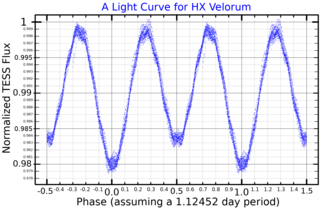
HX Velorum, also known as HR 3462 and HD 74455, is a star in the constellation Vela. It is a 5th magnitude star, so it will be faintly visible to the naked eye of an observer far from city lights. It is a variable star, whose brightness varies slightly from magnitude 5.48 to 5.53 over a period of 1.12 days.
















